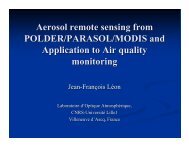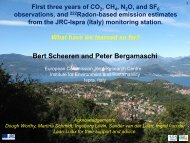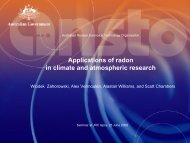Workshop “Atmospheric monitoring <strong>and</strong> inverse modelling for verification of national <strong>and</strong> EU bottom-up GHG inventories” - reportWorkshop "Atmospheric monitoring <strong>and</strong> inverse modelling for verification of national <strong>and</strong> EU bottomupGHG inventories " - reportchlorinated solvents (CCl 4 , CH 3 CCl 3 ), brominated organic compounds (halons,CH 3 Br) <strong>and</strong> HFCs (hydrofluorocarbons). Due to its broad coverage of Europe itprovides an important link between the global <strong>and</strong> regionally representativebackground concentrations.As an example the data series of HFC-134a is shown in Figure 2, where a commontrend in the background concentrations is overlaid by higher peak values atJungfraujoch <strong>and</strong> Monte Cimone, which are located nearer to important Europeansource regions in comparison to the more remote site of Mace Head <strong>and</strong> the Arcticsite of Ny-Alesund.HFC 134a200150ppt10050Monte CimoneJungfraujochMace HeadNy-Alesund02000 2001 2002 2003 2004Figure 2: Continuous in-situ measurements of HFC-134a at the four SOGE sites.Thus, as European sources can be detected at the SOGE stations, they providemeasurements which can be used are in support of the Kyoto <strong>and</strong> the Montrealprotocols, in assessing the compliance of European regions with the protocolrequirements. In particular the observation system has been set up to (i) detecttrends in the concentrations of greenhouse active <strong>and</strong> ozone-destroying halocarbons,(ii) verify reported emissions <strong>and</strong> validate emission inventories for a series ofhalocarbons for Europe as a whole as well as for certain regions, (iii) developobservational capacity for all halocarbons included in the Kyoto protocol for whichthis was previously not existing, <strong>and</strong> (iv) develop a strategy for a cost-effective longtermobservation system for halocarbons in Europe. The second objective has beento predict <strong>and</strong> assess impacts of the halocarbons on the climate <strong>and</strong> on the ozonelayer. This implies extensive exploitation of existing data.The European emissions of halocarbons are regularly estimated within SOGE withinseveral publications. For example, HCFC-141b emissions have been shown to have36
Workshop “Atmospheric monitoring <strong>and</strong> inverse modelling for verification of national <strong>and</strong> EU bottom-up GHG inventories” - reportWorkshop "Atmospheric monitoring <strong>and</strong> inverse modelling for verification of national <strong>and</strong> EU bottomupGHG inventories " - reportdeclined already after its ban from usage as foam blowing agent [Derwent et al.2007]. On the other h<strong>and</strong>, emissions from its substitutes (HFC-245fa <strong>and</strong> HFC-365mfc) have been estimated to have been increased enormously over the last years[Vollmer et al. 2006; Stemmler et al. 2007]. Furthermore, HFC-134a <strong>and</strong> HFC-152aemissions have been estimated over the last years [O'Doherty et al. 2004; Greally etal. 2007].In the last years SOGE has been extended to Asia. Within SOGE-A (Asia) a newinstrument has been deployed at a station North of Beijing to perform continuous insitumeasurements of ozone-depleting substances (CFCs, HCFCs, halons <strong>and</strong> longlivedchlorinated solvents). Resulting emission estimates will be the first of its kindfrom China <strong>and</strong> will be used to verify compliance of China with the requirements ofthe Montreal protocol <strong>and</strong> its amendments.ReferencesDerwent, R. G., P. G. Simmonds, B. R. Greally, S. O'Doherty, A. McCulloch, A. Manning, S.Reimann, D. Folini <strong>and</strong> M. K. Vollmer, The phase-in <strong>and</strong> phase-out of Europeanemissions of HCFC-141b <strong>and</strong> HCFC-142b under the Montreal Protocol: Evidence fromobservations at Mace Head, Irel<strong>and</strong> <strong>and</strong> Jungfraujoch, Switzerl<strong>and</strong> from 1994 to 2004,Atmospheric Environment, 41 (4): 757-767, 2007.Greally, B. R., A. J. Manning, S. Reimann, A. McCulloch, J. Huang, B. L. Dunse, P. G.Simmonds, R. G. Prinn, P. J. Fraser, D. M. Cunnold, S. O'Doherty, L. W. Porter, K.Stemmler, M. K. Vollmer, C. R. Lunder, N. Schmidbauer , O. Hermansen, J. Arduini, P. K.Salameh, P. B. Krummel, R. H. J. Wang, D. Folini, R. F. Weiss, M. Maione, G. Nickless,F. Stordal <strong>and</strong> R. G. Derwent, Observations of 1,1-difluoroethane (HFC-152a) at AGAGE<strong>and</strong> SOGE monitoring stations in 1994–2004 <strong>and</strong> derived global <strong>and</strong> regional emissionestimates, J. Geophys. Res., 112,: D06308, doi:10.1029/2006JD007527, 2007.O'Doherty, S., D. M. Cunnold, A. Manning, B. R. Miller, R. H. J. Wang, P. B. Krummel, P. J.Fraser, P. G. Simmonds, A. McCulloch, R. F. Weiss, P. Salameh, L. W. Porter, R. G.Prinn, J. Huang, G. Sturrock, D. Ryall, R. G. Derwent <strong>and</strong> S. A. Montzka, Rapid growth ofhydrofluorocarbon 134a <strong>and</strong> hydrochlorofluorocarbons 141b, 142b, <strong>and</strong> 22 fromAdvanced Global Atmospheric Gases Experiment (AGAGE) observations at Cape Grim,Tasmania, <strong>and</strong> Mace Head, Irel<strong>and</strong>, J. Geophys. Res., 109 (D6): art. no.-D06310, 2004.Stemmler, K., D. Folini, S. Ubl, M. K. Vollmer, S. Reimann, S. O'Doherty, B. Greally, P. G.Simmonds <strong>and</strong> A. Manning, European emissions of HFC-365mfc, a chlorine freesubstitute for the foam blowing agents HCFC-141b <strong>and</strong> CFC-11, Environ. Sci. Technol.41, 1145-1151, 2007.Vollmer, M. K., S. Reimann, D. Folini, L. W. Porter <strong>and</strong> L. P. Steele, First appearance <strong>and</strong>rapid growth of anthropogenic HFC-245fa (CHF 2 CH 2 CF 3 ) in the atmosphere, Geophys.Res. Lett. 33 (20), 2006.37








